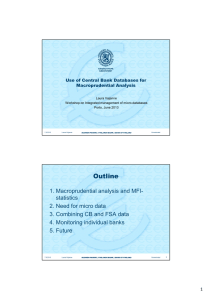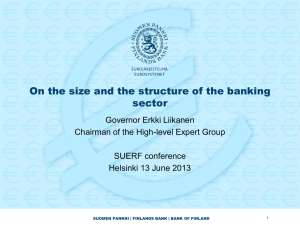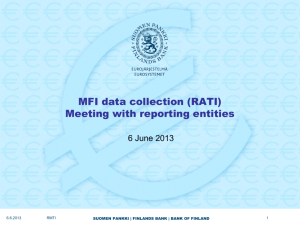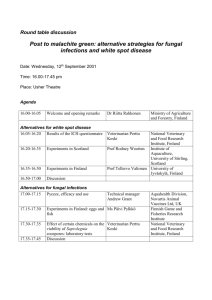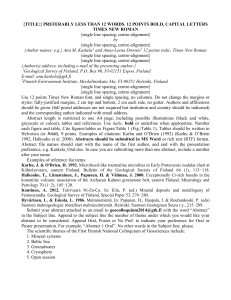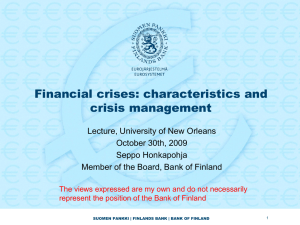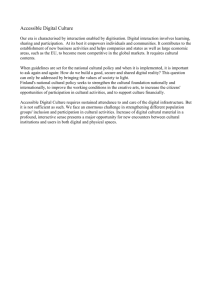Financial crises: characteristics and crisis management
advertisement
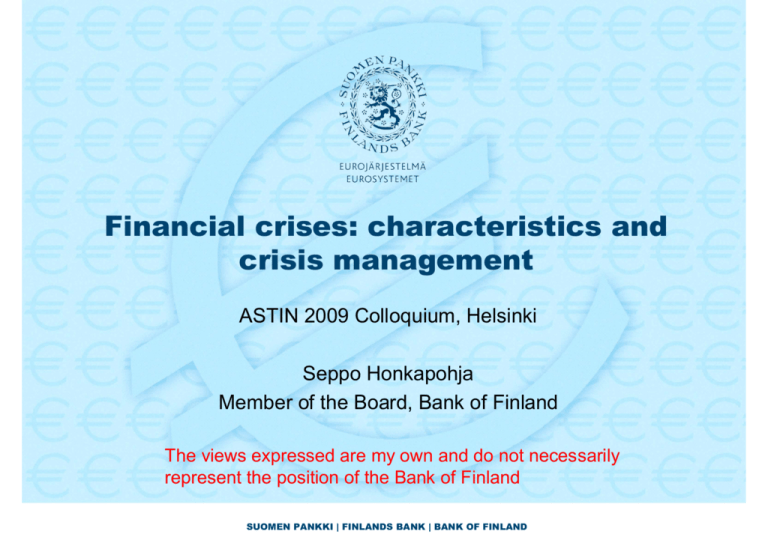
Financial crises: characteristics and crisis management ASTIN 2009 Colloquium, Helsinki Seppo Honkapohja Member of the Board, Bank of Finland The views expressed are my own and do not necessarily represent the position of the Bank of Finland SUOMEN PANKKI | FINLANDS BANK | BANK OF FINLAND Structure of presentation ♦ Introduction ♦ Causes of financial crises ♦ Empirical characteristics ♦ Crisis management ♦ Concluding comments SUOMEN PANKKI | FINLANDS BANK | BANK OF FINLAND I. Introduction ♦ Financial crises are when some financial institutions or assets suddenly lose a large part of their value. ♦ There are a number of different types of crises: – Banking crises (runs or related difficulties) – Speculative bubbles and crashes (stock markets, real estate) – Currency crises; isolated crises and contagion ♦ Systemic crises: a large number of institutions or assets behave in a non-sustainable way. SUOMEN PANKKI | FINLANDS BANK | BANK OF FINLAND ♦ The frequency of financial crisis doubled in the period since 1973 in comparison to 1945-71: – Annual frequency is about 12 percent in 1973-2001 period, vs. about 6,5 percent in 1945-71 (Bordo et al 2001). ♦ Excluding the current crisis, six out of ten biggest bubbles have occurred since 1970s (Table). ♦ Systemic crises have major macroeconomic consequences (Figures: Nordic crises in 1990s). SUOMEN PANKKI | FINLANDS BANK | BANK OF FINLAND The big ten financial bubbles (from Kindlberger and Aliber 2005) 1. 2. 3. 4. 5. The Dutch Tulip Bulb Bubble 1636 The South Sea Bubble 1720 The Mississippi Bubble 1720 The late 1920s stock price bubble 1927–29 The surge in bank loans to Mexico and other developing countries in the 1970s 6. The bubble in real estate and stocks in Japan 1985–89 7. The 1985–89 bubble in real estate and stocks in Finland, Norway and Sweden 8. The bubble in real estate and stocks in Thailand, Malaysia, Indonesia and several other Asian countries 1992–97 9. The surge in foreign investment in Mexico 1990–93 10. The bubble in over-the counter stocks in the United States 1995–2000 Source: C.P. Kindleberger and R. Z. Aliber: Manias, Panics and Crashes, A History of Financial Crises, 2005 SUOMEN PANKKI | FINLANDS BANK | BANK OF FINLAND 5 Figure 1. Real GDP growth Finland 8 Sweden Norway % 6 4 2 0 -2 -4 -6 -8 1980 1985 1990 Sources: Eurostat and IMF. 1995 2000 2005 SUOMEN PANKKI | FINLANDS BANK | BANK OF FINLAND Figure 2. Current account Finland 20 Sweden Norway % of GDP 15 10 5 0 -5 -10 1980 1985 1990 1995 Source: European Commission. 2000 2005 SUOMEN PANKKI | FINLANDS BANK | BANK OF FINLAND Loan losses/lending in the Nordic countries' banking sector 1985-1999, % 9 8 7 2 6 5 3 4 3 2 1 1 0 -1 1985 1987 1989 1 Norway 1991 2 Sweden 1993 1995 3 Finland Source: Central banks. SUOMEN PANKKI | FINLANDS BANK | BANK OF FINLAND 1997 1999 II. Causes of financial crises ♦ Fragility of financial systems – Intermediation, asset-liability mismatch – Strategic complementarity ♦ Amplifying factors – Imperfect knowledge and herd behavior – Credit and high leverage ♦ Collapse of asset prices – Liquidity problems – Possible contagion ♦ Regulatory failures SUOMEN PANKKI | FINLANDS BANK | BANK OF FINLAND II.1 Fragility of financial systems ♦ Strategic complementaries are common in financial markets – Successful investments require guess work about other investors (J.M. Keynes: financial markets are b” eauty contests”) – Investors choices are strategic complements: incentives to coordinate decisions => strategic complementarity ♦ Intermediation of funds creates asset-liability mismatches – Banks provide liquidity to depositors – Liquidity needed as the timing of use of funds is uncertain – Banks earn by lending to illiquid long-term investments SUOMEN PANKKI | FINLANDS BANK | BANK OF FINLAND ♦ Asset-liability mismatch can lead to bank runs (DiamondDybvig 1983) – These can be a self-fulling prophecy: depositors best response is to withdraw in response to withdrawals by other depositors. – A n” o-run”outcome is another equilibrium in this kind of system. ♦ Mismatch also arise e.g. from assets and liabilities in different currencies => currency crises – Currency crises usually emerge when currency exchange rates are fixed (or regulated). – Mobility of capital across the border is another precondition. SUOMEN PANKKI | FINLANDS BANK | BANK OF FINLAND II.2 Amplifying factors ♦ Imperfect knowledge and limitations in human reasoning: – These often lead to overestimated assets values after major financial and technical innovations. – Learning (gradual improvement of knowledge) and herding (imitation of other investors) lead to more volatility. ♦ High leverage contributes to financial crises. – If an institution or investor invests only his own money, the worst outcome is loss of these funds. – If additional funds are borrowed to invest more, then potential gains are increased but so are potential losses. – Moreover, bankcruptcy risk arises, which can spread financial troubles to other institutions and markets => contagion and increased systemic risk. SUOMEN PANKKI | FINLANDS BANK | BANK OF FINLAND ♦ Real shocks: – Adverse shocks in business cycles will reduce assets of banks. – If shocks are big, customers will anticipate weakness of a bank, triggering withdrawals and a possible run. – This is thought to be an alternative explanation to expectationsbased models. Both models thought to be relevant. ♦ Regulatory failures – – – – Thought to be important in the current crisis CDS market non-transparent Misguided regulation: Basel II led to procyclicality Fraud is often present (e.g. Madoff case), but in aggregate not so important SUOMEN PANKKI | FINLANDS BANK | BANK OF FINLAND II.3 Trade-offs ♦ Financial systems have important trade-offs: – Deeper intermediation improves allocation of resources and of risks. – Imperfect information can create liquidity problems,’ – Asymmetric information creates incentives that contribute to adverse outcomes (moral hazard, adverse selection). – Possibility of bad outcomes from asset-liability mismatches that become sour. SUOMEN PANKKI | FINLANDS BANK | BANK OF FINLAND III. Empirical Overview III.1 Duration and depth of systemic crises – peak to trough measures (Reinhard and Rogoff 2009) ♦ Real house prices: – average fall 35.5 percent; biggest fall 53 percent (Hong Kong 1997) – average duration 6 years; highest 17 years (Japan 1990s) ♦ Real equity prices: – average fall 55.9 percent; biggest fall 90 percent (Iceland 2007) – average duration 3.4 years; highest around 5 years (Spain 1977, Malaysia 1997, Thailand 1997) SUOMEN PANKKI | FINLANDS BANK | BANK OF FINLAND ♦ Real per capita GDP: – average fall 9.3 percent; biggest fall around 29 percent (US 1929) – average duration 1.9 years; highest 4 years (Finland 1991, Argentine 2001, US 1929) ♦ Unemployment: – average rise 7 percent; biggest rise 22 percent (US 1929) – average duration 4.8 years; highest 11 years (Japan 1992) ♦ Increase in public debt (3 years after a banking crisis) : – average rise 86 percent; biggest rise 180 percent (Finland 1991, Columbia 1998) SUOMEN PANKKI | FINLANDS BANK | BANK OF FINLAND III.2 The Current Crisis ♦ Next we look at the current crisis in the US and euro area. – Imbalances: current account, public debt – Asset prices: real house and equity prices ♦ Comparison to the average of the B ” ig Five”crises in advanced economies: – Nordics (Finland, Norway, Sweden) in 1990s, Spain in 1980s, Japan in 1990s ♦ Note: T represents the year of start of the financial crisis in the next figures . SUOMEN PANKKI | FINLANDS BANK | BANK OF FINLAND Current account 4 2 0 USA -2 Euro area Big 5 -4 -6 -8 t-4 t-3 t-2 t-1 T t+1 t+2 t+3 SUOMEN PANKKI | FINLANDS BANK | BANK OF FINLAND t+4 18 Public debt 350 300 250 200 Big 5 USA 150 Euro area 100 50 0 t-4 t-3 t-2 t-1 T t+1 t+2 t+3 SUOMEN PANKKI | FINLANDS BANK | BANK OF FINLAND t+4 19 Real equity prices 200 180 160 140 Big 5 120 USA Euro area 100 80 60 t-4 t-3 t-2 t-1 T t+1 t+2 t+3 t+4 SUOMEN PANKKI | FINLANDS BANK | BANK OF FINLAND Real house prices 130 120 110 Big 5 USA Euro area 100 90 80 t-4 t-3 t-2 t-1 T t+1 t+2 t+3 SUOMEN PANKKI | FINLANDS BANK | BANK OF FINLAND t+4 21 III.3 Special features of the current crisis ♦ The crisis is global and affects all countries. – Globalization of finance is challenging for policy making. ♦ Macroeconomic reasons behind the current crisis: – Global imbalances and s” avings glut”. – Loose monetary policy: low interest rates after the burst of the IT bubble. ♦ Financial innovation: – Originate-and-distribute banking model, – New complex and opaque instruments, – Shadow banking system to permit a lot of securitization, more leverage and risk-taking. – Housing boom fuelled by the new practices and excessive lending SUOMEN PANKKI | FINLANDS BANK | BANK OF FINLAND IV. Crisis management ♦ We look at the practices and experiences from the 1990s Nordic crises. ♦ Comparison to resolution of the US Savings and Loans crisis in the late 1980s and early 1990s. SUOMEN PANKKI | FINLANDS BANK | BANK OF FINLAND IV.1 The Nordic experience ♦ Finland – 1st measure: Bank of Finland took control of Skopbank in September 1991 – Public support: preferred capital certificates to banks, with strict requirements – Support to be converted into shares if not repaid – Government set up the crisis management agency to restructure the banking system – Policy-makers made promises to guarantee banks’obligations, also further public support SUOMEN PANKKI | FINLANDS BANK | BANK OF FINLAND ♦ Finland (continued) – Banks became profitable again in 1996 – Improved efficiency (staff halved, etc.) – Major restructuring of banking system: •savings banks largely disappeared, •one big commercial bank was merged to another •remaining comm. bank merged with Nordebanken – Nowadays 60 percent of banks owned by foreigners => Biggest part of the crisis was in Savings Banks SUOMEN PANKKI | FINLANDS BANK | BANK OF FINLAND ♦ Sweden – Crisis erupted in autumn 1991 with Första Sparbanken; government gave a loan and FS merged with other savings banks – Nordbanken (3rd largest comm. bank) was 71% govt owned and had to be recapitalized – Many banks made heavy credit losses – In autumn 1992 blanket creditor guarantee by government – Crisis resolution agency set up, public support with strict criteria in risk reduction and efficiency SUOMEN PANKKI | FINLANDS BANK | BANK OF FINLAND ♦ Sweden (continued) – Some banks did not need public support ⇒ In the end nearly all support went into two banks, Gotabanken and Nordbanken. ⇒ Nordbanken became a pan-Nordic bank N ” ordea”. SUOMEN PANKKI | FINLANDS BANK | BANK OF FINLAND ♦ Norway – Crisis erupted in autumn 1988 – Initially private guarantee funds provided support and bank mergers took place – In late 1990 private funds were exhausted, so government guarantee funds set up in early 1991 – Support had to be converted into solvency support – In autumn 1991 capital support needed – In Spring 1992 several banks, incl. three biggest commercial banks were nationalized SUOMEN PANKKI | FINLANDS BANK | BANK OF FINLAND ♦ Norway (continued): – no blanket guarantee by government, but specific announcements about securing depositors and creditors – Banks’situation started to improve in 1993 – One of the nationalized banks was sold in 1995 and two other banks were sold later – Government still owns 34 percent of one bank => In the end the Norwegian tax payer made money out of the crisis. Next table shows gross and net fiscal costs. SUOMEN PANKKI | FINLANDS BANK | BANK OF FINLAND Gross cost Net cost Finland 9.0 (% of 1997 GDP) 5.3 (% of 1997 GDP) Norway 2.0 (% of 1997 GDP), 3.4 (present value , % of 2001 GDP) Sweden 3.6 (% of 1997 GDP) SUOMEN PANKKI | FINLANDS BANK | BANK OF FINLAND -0.4 (present value, % of 2001 GDP) 0.2 (% of 1997 GDP) IV.2 The US savings and loan crisis ♦ S&Ls (aka thrifts) were cooperative organizations: – Saving accounts, home mortgages were initial business activities – In 1970s regulators controlled deposit rates; deregulation of thrift industry at the end of 1970s – Big expansion into new and risky business areas • Consumer and commercial loans, transaction accounts, credit cards • Investments in commercial real estate. ♦ Many failures in early 1980s: hundreds of S&Ls failed during 1980-90s. ♦ Total cost was about 160 billion USD, with about 124 paid by US government. SUOMEN PANKKI | FINLANDS BANK | BANK OF FINLAND ♦ US government (FSLIC) had to pay deposit insurance and close nearly 300 S&Ls in 1986-1989. ♦ Resolution Trust Corporation in 1989-95 to liquidate assets from insolvent S&Ls. – RTC used e” quity partnerships”to achieve better execution of liquidation (a variety of schemes) – Private sector partners acquired partial interest in a pool of assets, controlled the sale of the poo,l and paid distributions to RTC. ♦ RTC was an asset disposition agency, not for restructuring. SUOMEN PANKKI | FINLANDS BANK | BANK OF FINLAND V. Some lessons for crisis management ♦ Nordic crises as example V.1 Prevention of major crisis ♦ This is the first priority => stability-oriented macro policies ♦ How to diagnose an overheating situation? – rapid credit expansion – strong increase in leverage – big external deficits in open economies ♦ Political-economy reasons can be a major obstacle in crisis prevention. SUOMEN PANKKI | FINLANDS BANK | BANK OF FINLAND V.2 Crisis management ♦ Maintaining confidence in the banking system is crucial – Broad political support and speedy response are important – Political guarantees to banks’obligations in Finland and Sweden but not in Norway ♦ The role of central banks: liquidity provision, emergency loans – Liquidity support in Norway and Sweden – Bank of Finland had to take over a problem bank SUOMEN PANKKI | FINLANDS BANK | BANK OF FINLAND ♦ Restructuring of the banking system - Crisis resolution agencies were used all Nordic countries Capital injections to banks - treatment of o” ld shareholders”was mixed - Guidance of restructuring of the banking system Administrative separation from central bank and ministry of finance ♦ Asset management companies (”bad banks”) to deal with non-performing assets – Norway: banks had their own bad banks – Finland and Sweden had public agencies – A private good bank / bad bank scheme used by Finnish cooperative banks SUOMEN PANKKI | FINLANDS BANK | BANK OF FINLAND VI Concluding comments ♦ We are very much in the middle of the current crisis, a lot has been done. ♦ Coordinated macroeconomic response – Quick easing of monetary policy by the Federal Reserve, ECB and other central banks – Expansionary fiscal policy ♦ Confidence in banking system – Loss of confidence was a huge concern in October 2008 – Increased levels of deposit insurance – Announcements of public schemes for recapitalizating banks ♦ Restructuring and recapitalization of banking systems are ongoing. SUOMEN PANKKI | FINLANDS BANK | BANK OF FINLAND Banks’writedowns and capital raised (May 27, 2009) Wells Fargo ( Wachovia) US gov’ t Citigroup US gov’ t Bank of America Bank of America ( Merrill Lynch) CH gov’ t UBS ( Washington Mutual) JPMorgan Chase HSBC JPMorgan Chase UK gov’ t RBS UK gov’ t Lloyds TSB ( HBOS) US gov’ t Wells Fargo PNC Bank ( National City) Morgan Stanley US gov’ t Barclays Deutsche Bank CH gov’ t Credit Suisse Bayerische LB Lehman Brothers ING Groep NL gov’ t Lone Star fund IKB BNP Paribas PNC Financial Services Group FR gov’ t Societe Generale US gov’ t Total writedowns 1473 USD bn and raised capital 1213 USD bn 0 20 Raised capital 40 60 80 Writedowns Source: Bloomberg. SUOMEN PANKKI | FINLANDS BANK | BANK OF FINLAND 100 120 USD bn ♦ Management of toxic assets has been initiated: – More difficult than in earlier crises because of asset complexity. – Asset management companies in some countries. – Geither scheme in the U.S. ♦ Reform of financial regulation and supervision – Need for international cooperation as finance is global or trancends national boundaries – G20 coordination: Financial Stability Board – Reform plans being drawn up in the EU (De Larosiére Report) SUOMEN PANKKI | FINLANDS BANK | BANK OF FINLAND ♦ It is much too early to reach strong conclusions about the management of the current crisis. ♦ Crisis prevention failed, but – troubled financial institutions are being treated in different countries, and – the internationally coordinated policy response has been encouraging. SUOMEN PANKKI | FINLANDS BANK | BANK OF FINLAND Thank you SUOMEN PANKKI | FINLANDS BANK | BANK OF FINLAND
